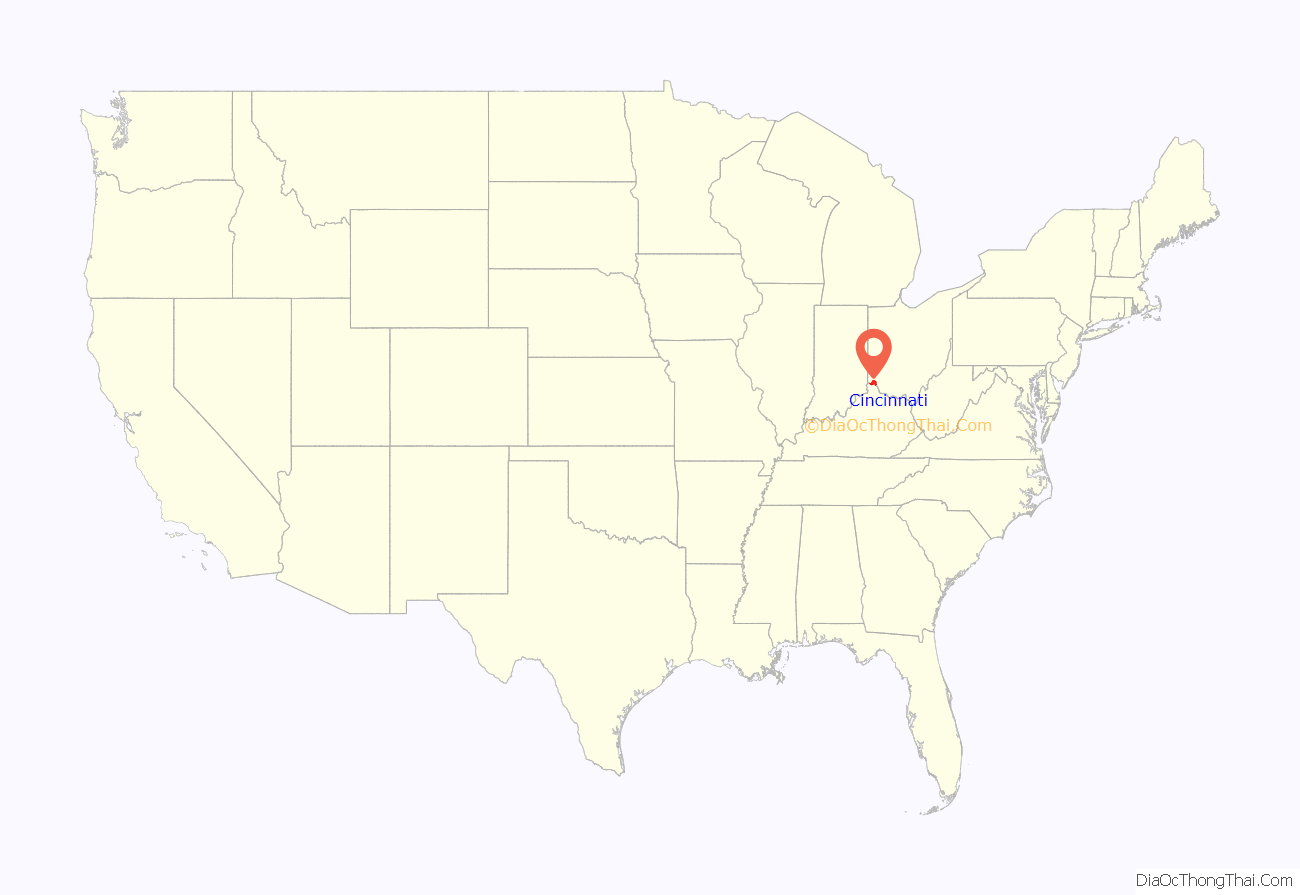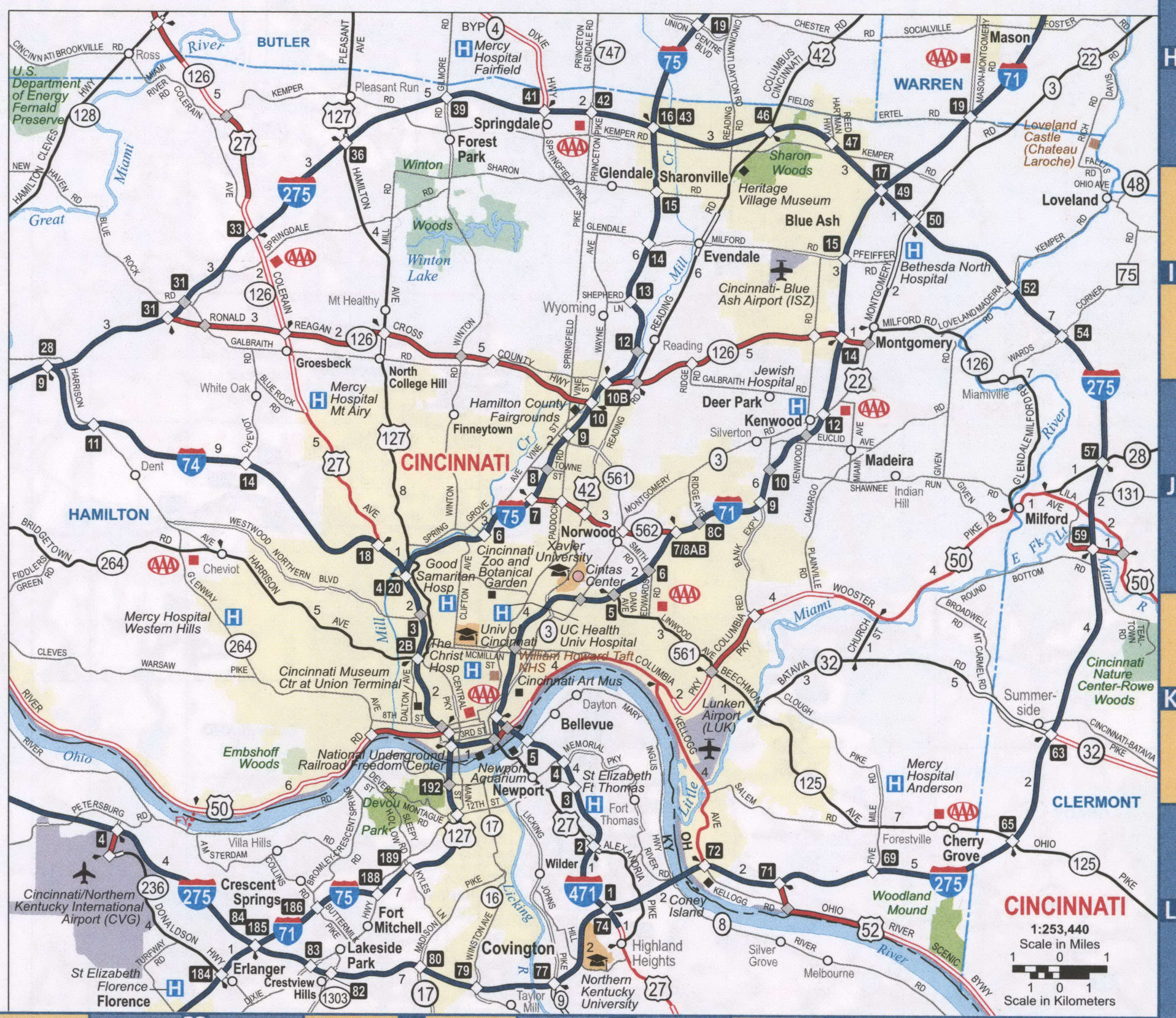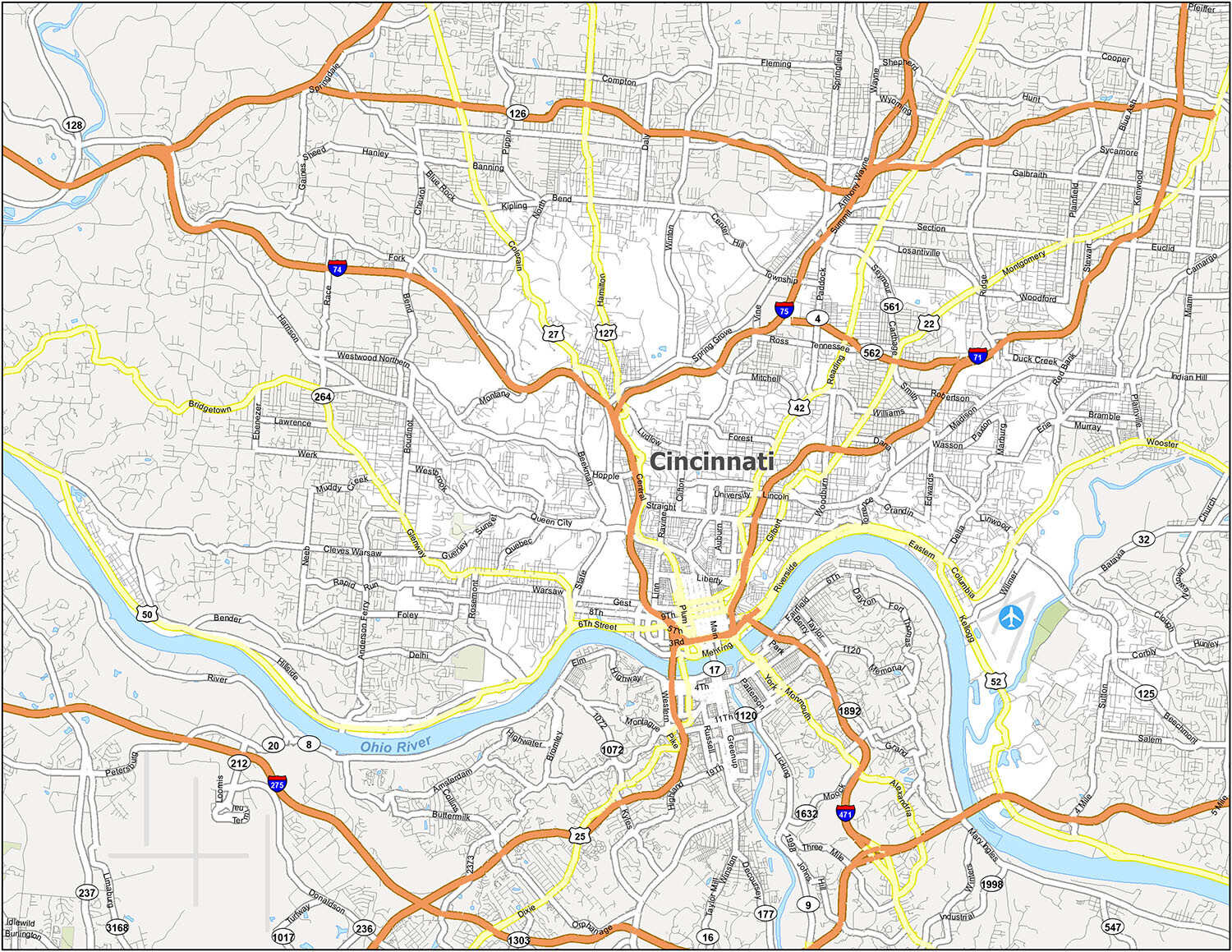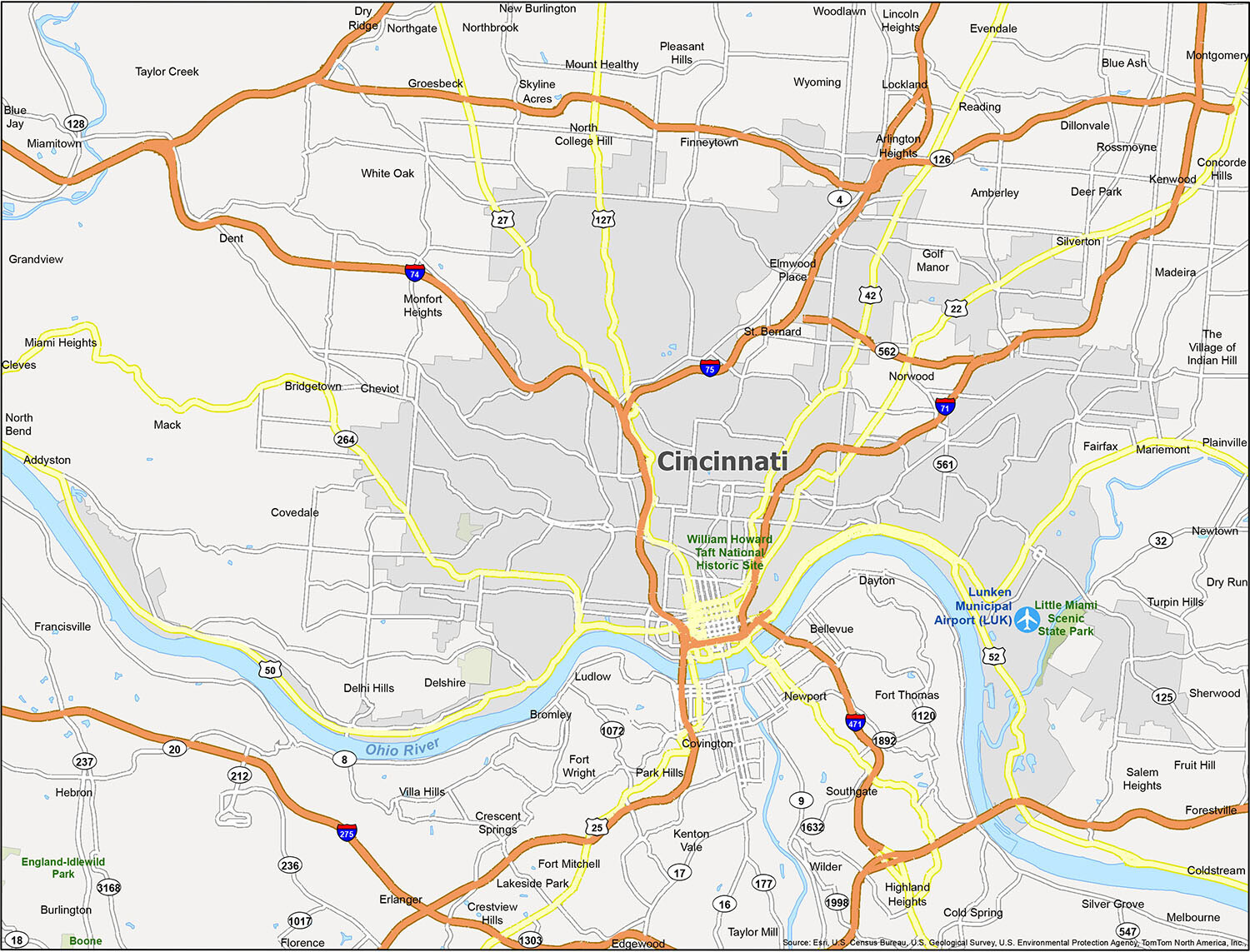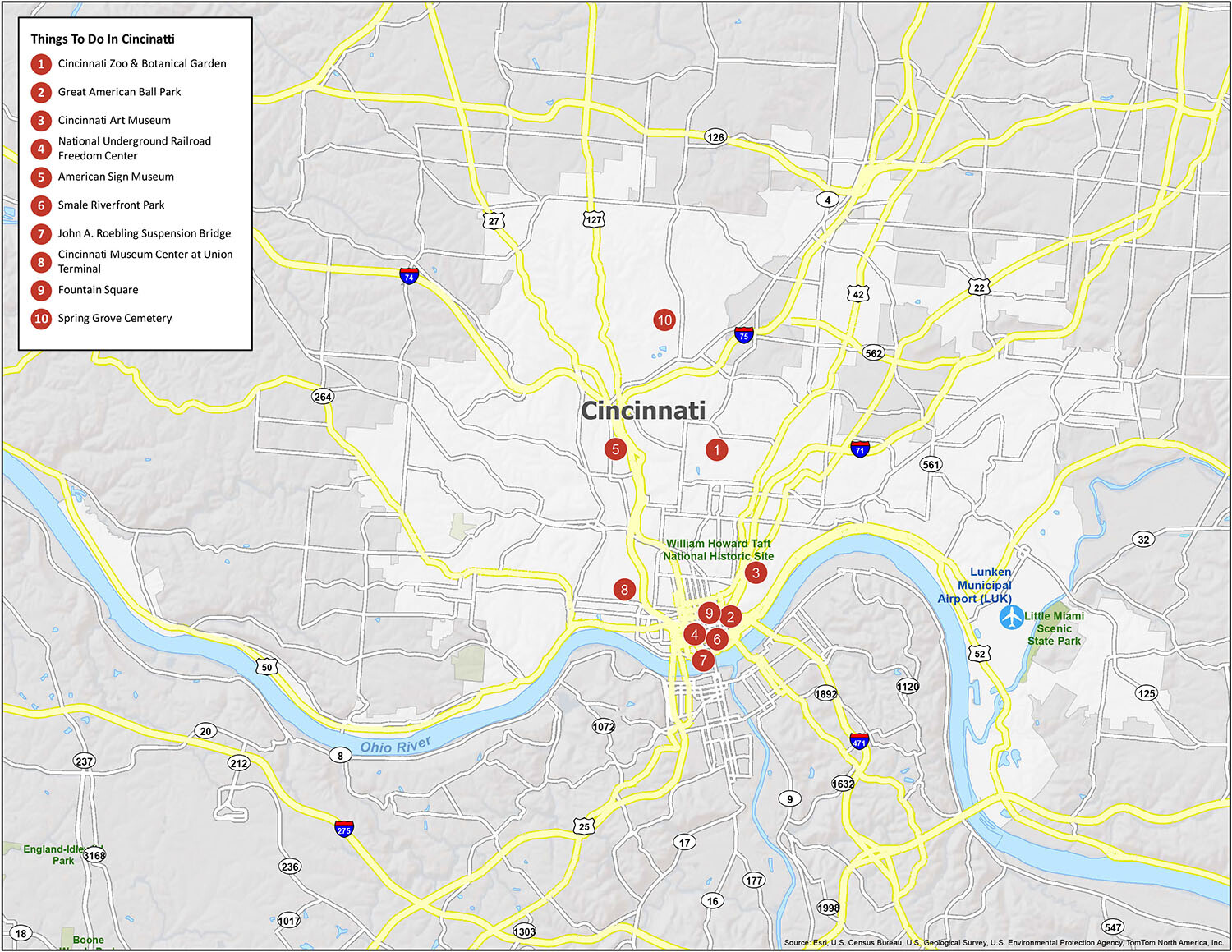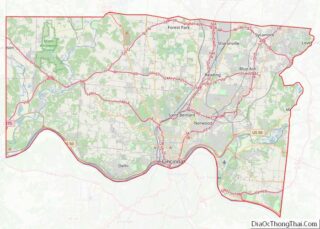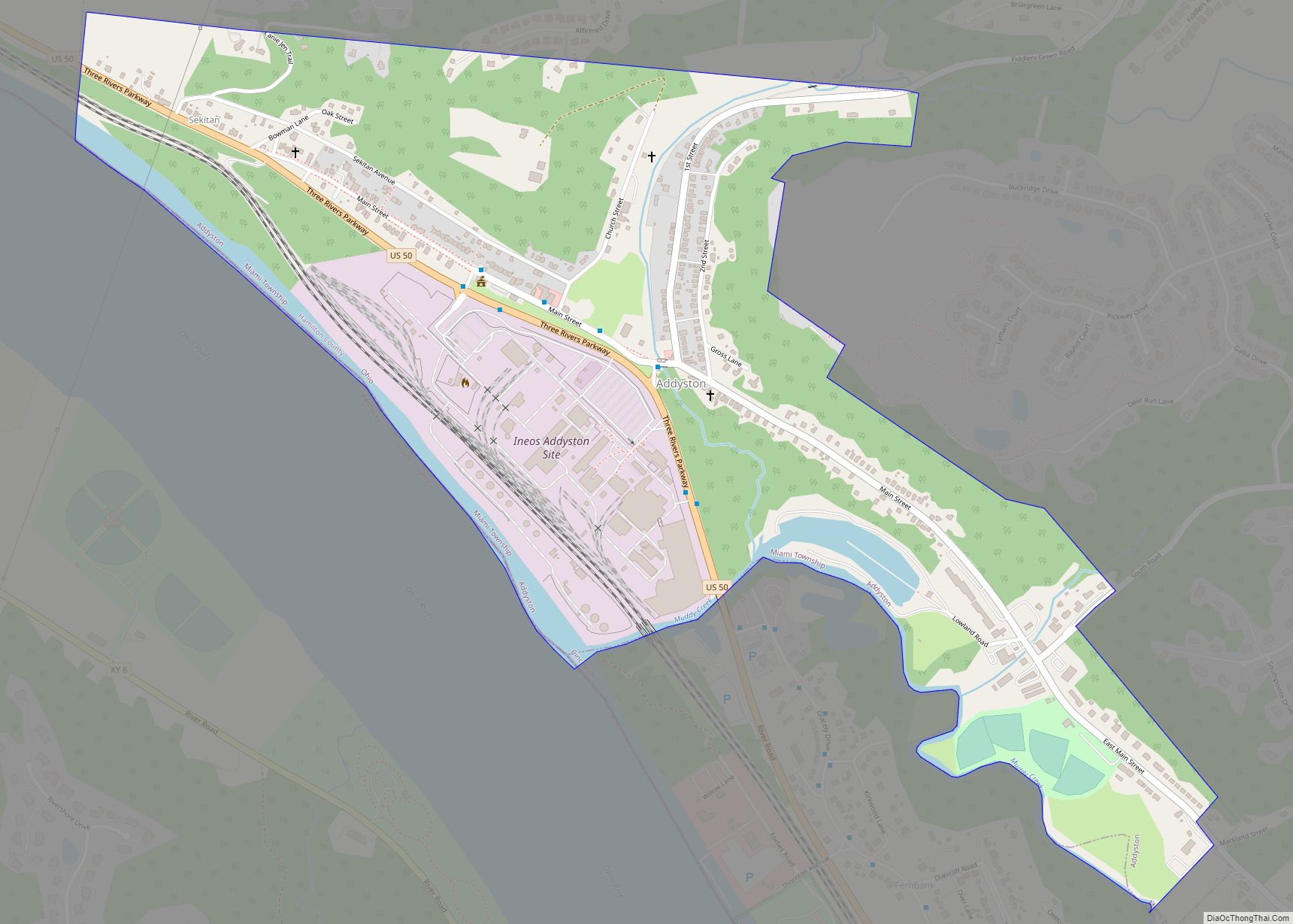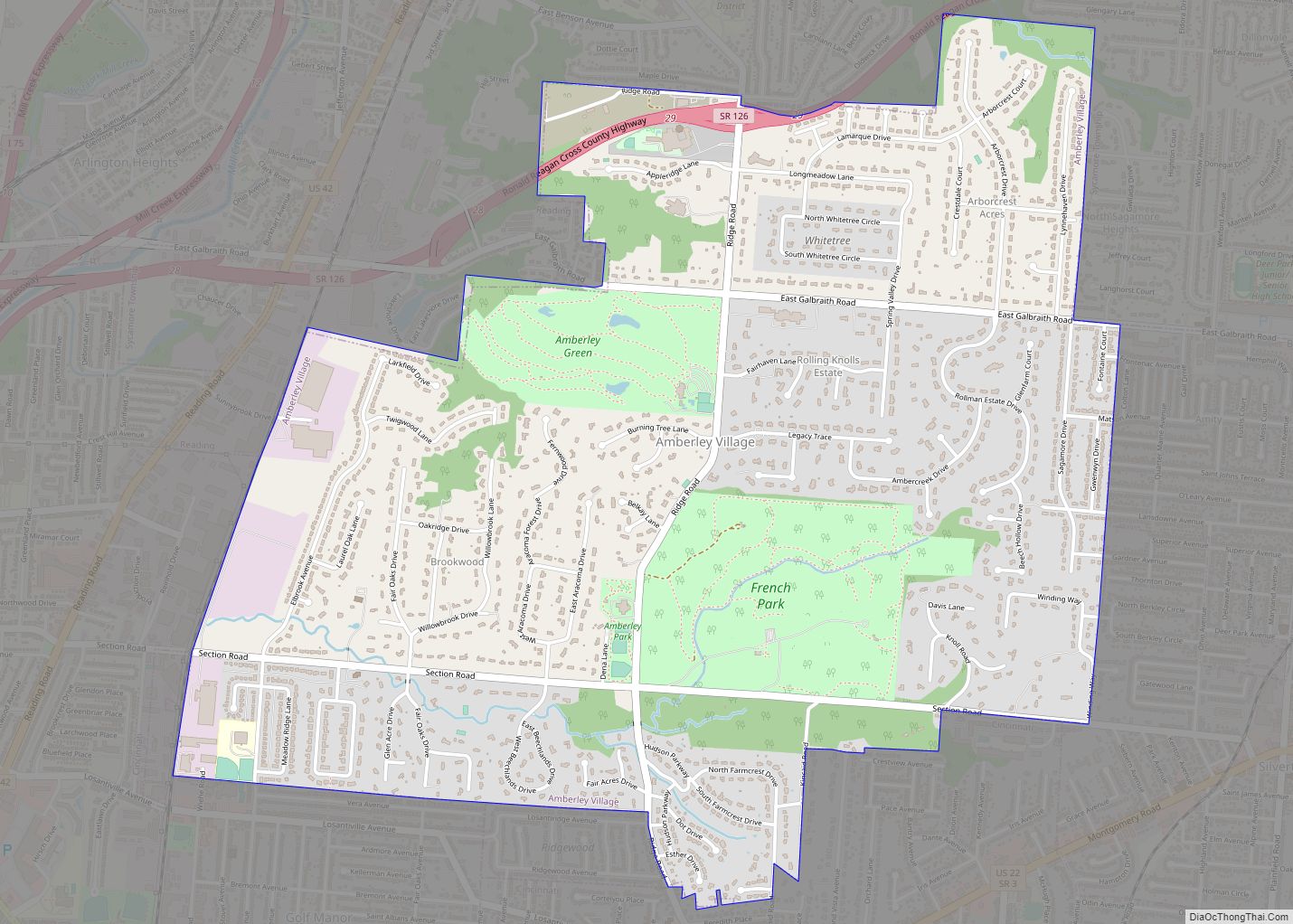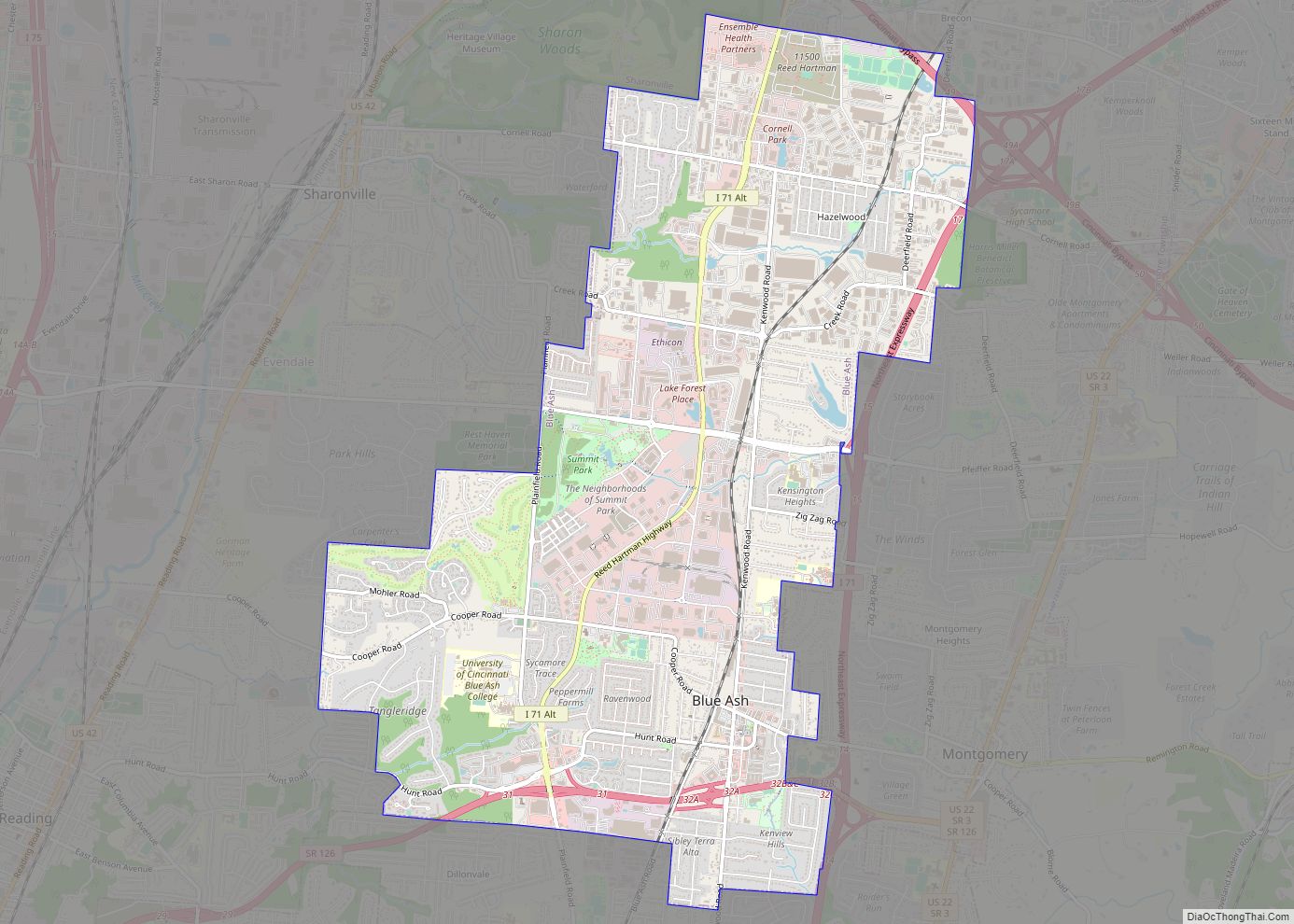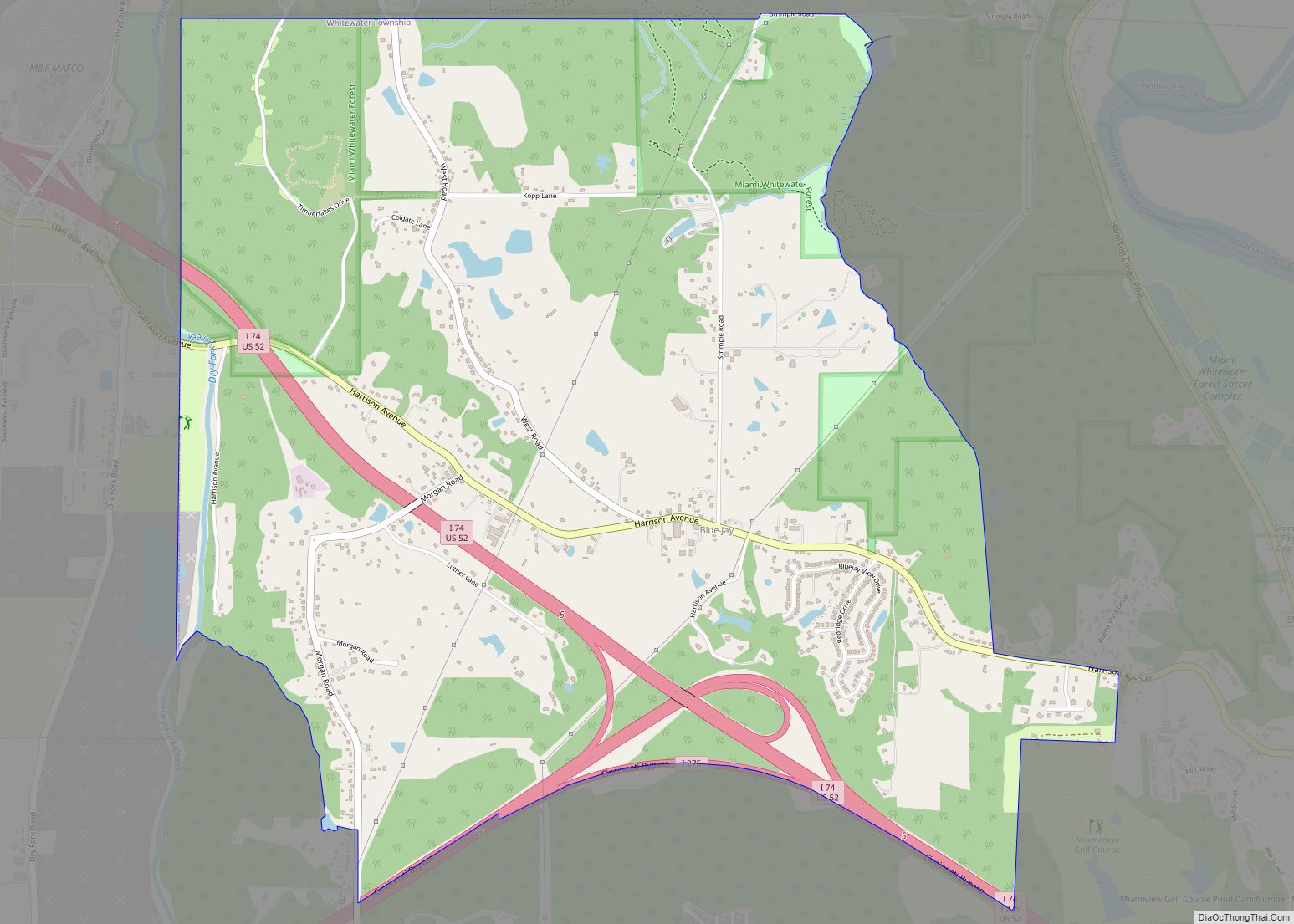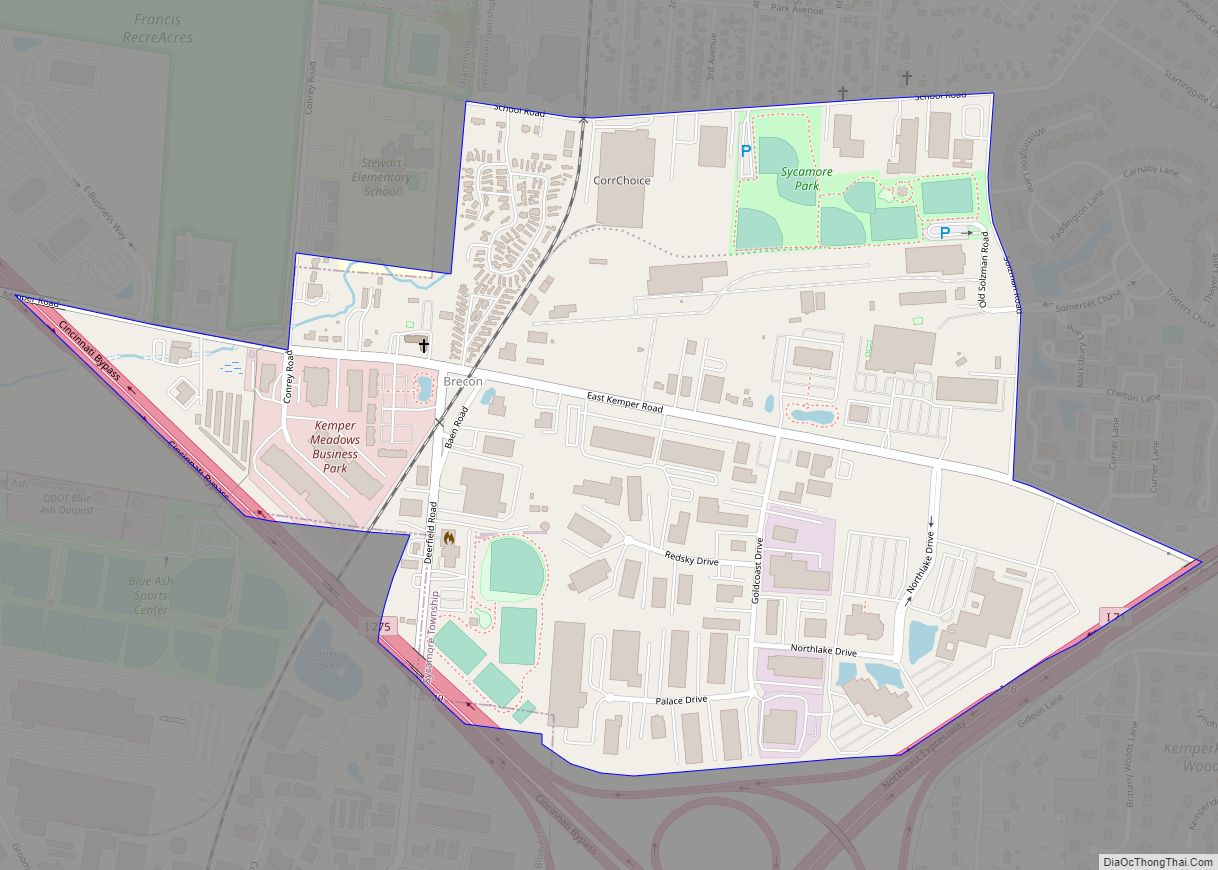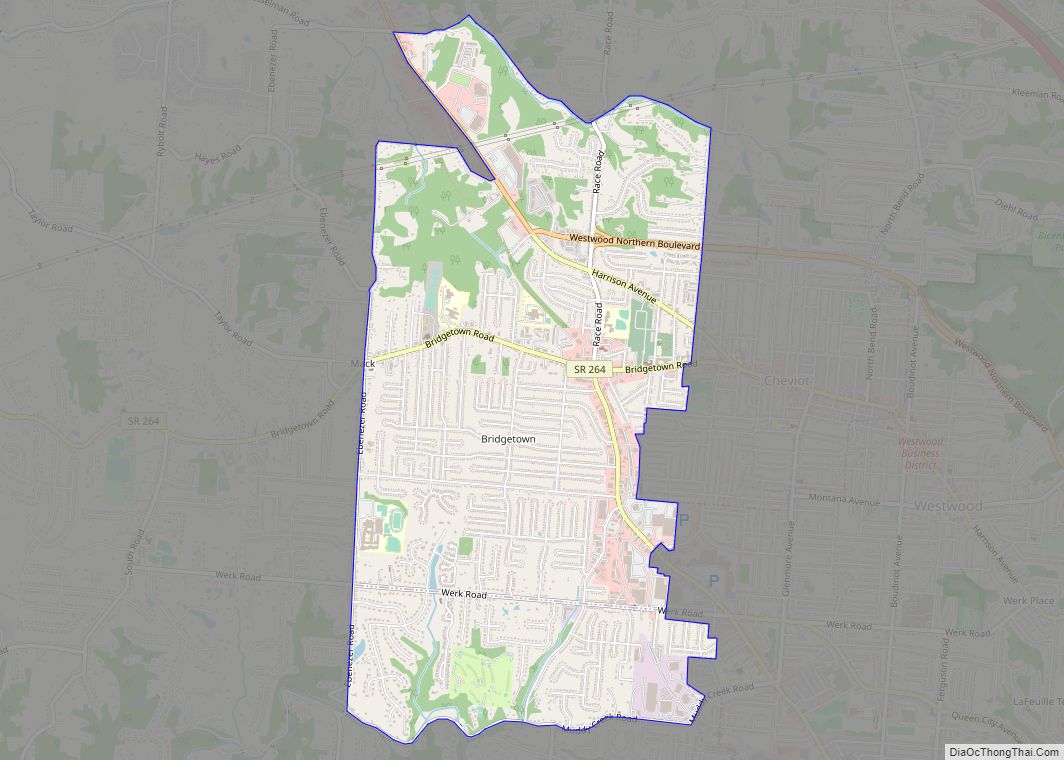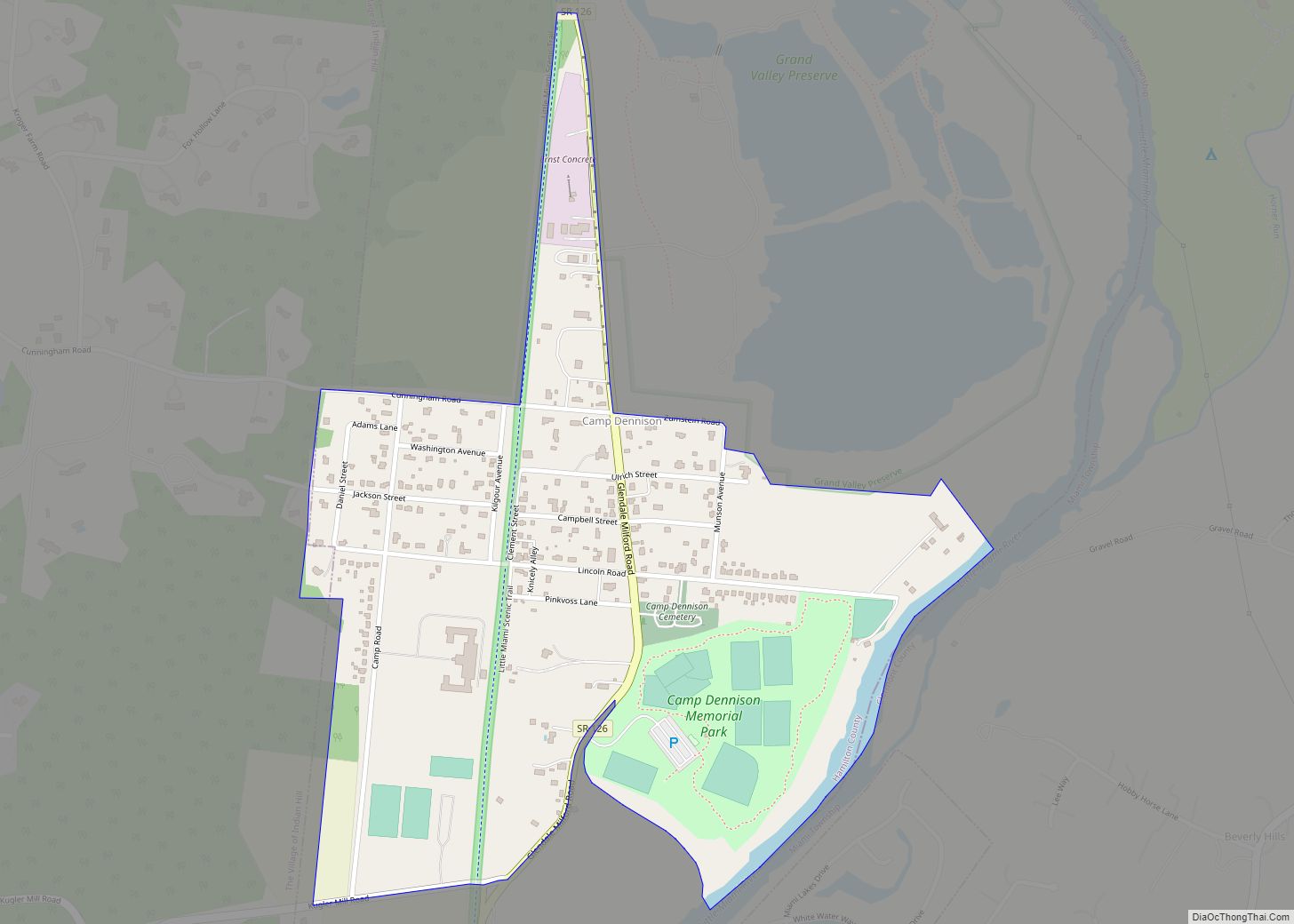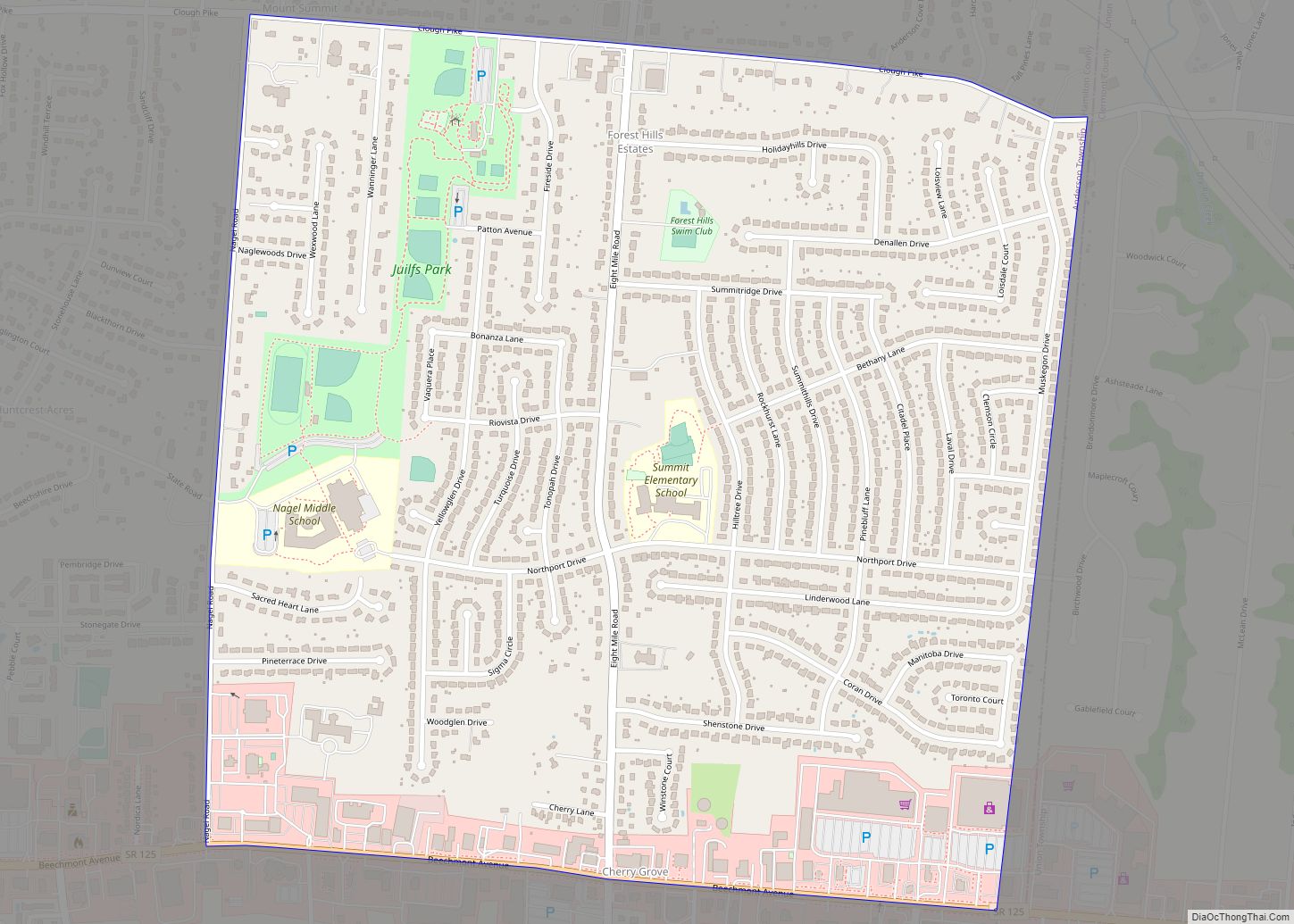Cincinnati (/ˌsɪnsɪˈnæti/ SIN-si-NAT-ee) is a city in the U.S. state of Ohio and the county seat of Hamilton County. Settled in 1788, the city is located at the northern side of the confluence of the Licking and Ohio rivers, the latter of which marks the state line with Kentucky. The city is the economic and cultural hub of the Cincinnati metropolitan area. With an estimated population of 2,265,051, it is Ohio’s largest metropolitan area and the nation’s 30th-largest, and with a city population of 309,317, Cincinnati is the third-largest city in Ohio and 65th in the United States. Throughout much of the 19th century, it was among the top 10 U.S. cities by population, surpassed only by New Orleans and the older, established settlements of the United States eastern seaboard, as well as being the sixth-most populous city from 1840 until 1860.
As a river town crossroads at the junction of the North, South, East, and West, Cincinnati developed with fewer immigrants and less influence from Europe than East Coast cities in the same period. However, it received a significant number of German-speaking immigrants, who founded many of the city’s cultural institutions. By the end of the 19th century, with the shift from steamboats to railroads drawing off freight shipping, trade patterns had altered and Cincinnati’s growth slowed considerably. The city was surpassed in population by other inland cities, particularly Chicago, which developed based on strong commodity exploitation, economics, and the railroads, and St. Louis, which for decades after the Civil War served as the gateway to westward migration.
Cincinnati is home to three professional sports teams: the Cincinnati Reds of Major League Baseball; the Cincinnati Bengals of the National Football League; and FC Cincinnati of Major League Soccer; it is also home to the Cincinnati Cyclones, a minor league ice hockey team. The city’s largest institution of higher education, the University of Cincinnati, was founded in 1819 as a municipal college and is now ranked as one of the 50 largest in the United States. Cincinnati is home to historic architecture with many structures in the urban core having remained intact for 200 years. In the late 1800s, Cincinnati was commonly referred to as the “Paris of America”, due mainly to such ambitious architectural projects as the Music Hall, Cincinnatian Hotel, and Shillito Department Store. Cincinnati is the birthplace of William Howard Taft, the 27th President and former Chief Justice of the United States. Recently, Cincinnati has been named among the 100 most livable cities in the world, at number 88, and is on many Best Places to Live lists, including Livability.com and US News and World Report.
| Name: | Cincinnati city |
|---|---|
| LSAD Code: | 25 |
| LSAD Description: | city (suffix) |
| State: | Ohio |
| County: | Hamilton County |
| Elevation: | 482 ft (147 m) |
| Total Area: | 79.64 sq mi (206.26 km²) |
| Land Area: | 77.91 sq mi (201.80 km²) |
| Water Area: | 1.72 sq mi (4.46 km²) |
| Total Population: | 309,317 |
| Population Density: | 3,969.98/sq mi (1,532.81/km²) |
| Area code: | 513 |
| FIPS code: | 3915000 |
| GNISfeature ID: | 1066650 |
| Website: | cincinnati-oh.gov |
If you’re looking for a road map, reference map, or interactive map of Cincinnati (the Queen City), then you’ve come to the right place. Here, you’ll find a comprehensive map of the city, which includes all the major attractions, streets, and neighborhoods. Our map will help you plan your trip and find all the best things to do in Cincinnati. This includes the zoo, bridge, stadium, museum, and Fountain Square.
From the vibrant cityscape to the historic neighborhoods, this map collection provides an easy-to-use, comprehensive overview of Cincinnati, including the location and information you need to plan your trip. So, let’s get started with an interactive map of the city.
Online Interactive Map
Click on ![]() to view map in "full screen" mode.
to view map in "full screen" mode.
Enjoy the best of Cincinnati with this map to help you find the best attractions and the best places to eat. Find out where the best shops and restaurants are, how to get there, and where to stay. With this interactive map, you will never get lost again in this city. With our Cincinnati map, you can find the best restaurants, parks, and attractions with ease.
Cincinnati location map. Where is Cincinnati city?
History
Etymology
Two years after the founding of the settlement then known as “Losantiville”, Arthur St. Clair, the governor of the Northwest Territory, changed its name to “Cincinnati”, possibly at the suggestion of the surveyor Israel Ludlow, in honor of the Society of the Cincinnati. St. Clair was at the time president of the Society, made up of Continental Army officers of the Revolutionary War who named their club for Lucius Quinctius Cincinnatus, a dictator in the early Roman Republic who saved Rome from a crisis, and then retired to farming because he did not want to remain in power.
Early history
Cincinnati began in 1788 when Mathias Denman, Colonel Robert Patterson, and Israel Ludlow landed at a spot at the northern bank of the Ohio opposite the mouth of the Licking and decided to settle there. The original surveyor, John Filson, named it “Losantiville”. On January 4, 1790, St. Clair changed the name of the settlement to honor the Society of the Cincinnati.
In 1811, the introduction of steamboats on the Ohio River opened up the city’s trade to more rapid shipping, and the city established commercial ties with St. Louis, Missouri, and New Orleans downriver. Cincinnati was incorporated as a city on March 1, 1819. Exporting pork products and hay, it became a center of pork processing in the region. From 1810 to 1830, the city’s population nearly tripled, from 9,642 to 24,831.
Construction on the Miami and Erie Canal began on July 21, 1825, when it was called the Miami Canal, related to its origin at the Great Miami River. The first section of the canal was opened for business in 1827. In 1827, the canal connected Cincinnati to nearby Middletown; by 1840, it had reached Toledo.
Railroads were the next major form of commercial transportation to come to Cincinnati. In 1836, the Little Miami Railroad was chartered. Construction began soon after, to connect Cincinnati with the Mad River and Lake Erie Railroad, and provide access to the ports of the Sandusky Bay on Lake Erie.
During the time, employers struggled to hire enough people to fill positions. The city had a labor shortage until large waves of immigration by Irish and Germans in the late 1840s. The city grew rapidly over the next two decades, reaching 115,000 people by 1850.
During this period of rapid expansion and prominence, residents of Cincinnati began referring to the city as the Queen City.
Industrial development and Gilded Age
Cincinnati’s location, on the border between the free state of Ohio and the slave state of Kentucky, made it a prominent location for slaves to escape the slave-owning south. Many prominent abolitionists also called Cincinnati their home during this period, and made it a popular stop on the Underground Railroad. In 2004, the National Underground Railroad Freedom Center was completed along Freedom Way in Downtown, honoring the city’s involvement in the Underground Railroad.
In 1859, Cincinnati laid out six streetcar lines; the cars were pulled by horses and the lines made it easier for people to get around the city. By 1872, Cincinnatians could travel on the streetcars within the city and transfer to rail cars for travel to the hill communities. The Cincinnati Inclined Plane Company began transporting people to the top of Mount Auburn that year. In 1889, the Cincinnati streetcar system began converting its horse-drawn cars to electric streetcars.
In 1880, the city government completed the Cincinnati Southern Railway to Chattanooga, Tennessee. It is the only municipally-owned interstate railway in the United States.
In 1884, outrage over a manslaughter verdict in what many observers thought was a clear case of murder triggered the Courthouse riots, one of the most destructive riots in American history. Over the course of three days, 56 people were killed and over 300 were injured. The riots ended the regime of Republican boss Thomas C. Campbell.
During the Great Depression
An early rejuvenation of downtown began in the 1920s and continued into the next decade with the construction of Union Terminal, the post office, and the large Cincinnati and Suburban Telephone Company Building. Cincinnati weathered the Great Depression better than most American cities of its size, largely due to a resurgence in river trade, which was less expensive than transporting goods by rail. The flood of 1937 was one of the worst in the nation’s history and destroyed many areas along the Ohio valley. Afterward the city built protective flood walls.
Nicknames
Cincinnati has many nicknames, including Cincy, The Queen City, The Queen of the West, The Blue Chip City, and The City of Seven Hills. These are more typically associated with professional, academic, and public relations references to the city, including restaurant names such as Blue Chip Cookies, and are not commonly used by locals in casual conversation, with the exception of Cincy, which is often used to refer to the city in absentia.
“The City of Seven Hills” stems from the June 1853 edition of the West American Review, “Article III—Cincinnati: Its Relations to the West and South”, which described and named seven specific hills. The hills form a crescent around the city: Mount Adams, Walnut Hills, Mount Auburn, Vine Street Hill, College Hill, Fairmont (now rendered Fairmount), and Mount Harrison (now known as Price Hill). The name refers to ancient Rome, reputed to be built on seven hills.
“Queen City” is taken from an 1819 newspaper article and further immortalized by the 1854 poem “Catawba Wine”. In it, Henry Wadsworth Longfellow wrote of the city:
For many years, Cincinnati was also known as “Porkopolis”; this nickname came from the city’s large pork interests.
Newer nicknames such as “The ‘Nati” are emerging and are attempted to be used in different cultural contexts. For example, the local Keep America Beautiful affiliate, Keep Cincinnati Beautiful, introduced the catchphrase “Don’t Trash the ‘Nati” in 1998 as part of a litter-prevention campaign.
Cincinnati Road Map
Find your way around the city with this detailed map. This map is the perfect companion to your trip to Ohio’s Queen City and is available for free. Our Cincinnati road map provides you with a comprehensive bird’s-eye view of the city, featuring points of interest and transportation routes. Otherwise, use the Ohio road map for any travel outside the city.
Interstate Highways: I-71, I-74, I-75, I-275, I-471
US Highways: 4, 22, 27, 32, 42, 50, 52, 126, 127, 562, 561
Parkways/Expressways: Central Pky, Columbia Pky
Major Roads: 3rd St, 5th St, 6th St, 7th St, 9th St, Bates Ave, Beechmont Ave, Broadway St, Central Ave, Colerain Ave, Delta Ave, Dorchester Ave, Eastern Ave, Eden Park Dr, Edmondson Rd, Edwards Rd, Elm St, Elsinore Ave, Elsinore Pl, English St, Ezzard Charles Dr, Freeman Ave, Gilbert Ave, Glenway Ave, Hamilton Ave, Hopple St, Kellogg Ave, Linwood Ave, Ludlow Ave, Main St, Montgomery Rd, Observatory Ave, Paddock Rd, Pete Rose Way, Plum St, Race St, Reading Rd, River Rd, Riverside Dr, Roebling Suspension Bridge, Rosa Parks St, Seymour Ave, State Ave, Sycamore St, Theodore M Barry, Vine St, Walnut St
Cincinnati is full of hidden gems that are well worth a visit. Discover a new part of our city that you might not have considered. With this map, you can explore the nearby communities, state parks, and historic sites that make Cincinnati a must-see destination. For population, it’s the third-largest city after Columbus and Cleveland. Cities include Bellevue, Blue Ash, Bromley, Cheviot, Cincinnati, Cold Spring, Covington, Crescent Springs, Crestview, Crestview Hills, Dayton, Deer Park, Edgewood, Erlanger, Florence, Fort Mitchell, Fort Thomas, Fort Wright, Highland Heights, Kenton Vale, Lakeside Park, Ludlow, Madeira, Melbourne, Montgomery, Mount Healthy, Newport, North College Hill, Norwood, Park Hills, Reading, Silver Grove, Southgate, Taylor Mill, The Village of Indian Hill, Villa Hills, Wilder, Woodlawn, and Wyoming. Villages include Addyston, Amberley, Arlington Heights, Cleves, Elmwood Place, Evendale, Fairfax, Golf Manor, Lincoln Heights, Lockland, Mariemont, Newtown, North Bend, Silverton, St. Bernard, and Woodlawn. Census-designated places (CDPs) include Blue Jay, Bridgetown, Burlington, Coldstream, Concorde Hills, Covedale, Delhi Hills, Delshire, Dent, Dillonvale, Dry Ridge, Dry Run, Finneytown, Forestville, Francisville, Fruit Hill, Grandview, Groesbeck, Hebron, Kenwood, Mack, Miami Heights, Miamitown, Monfort Heights, New Burlington, Northbrook, Northgate, Plainville, Pleasant Hills, Rossmoyne, Salem Heights, Sherwood, Skyline Acres, Taylor Creek, Turpin Hills, and White Oak.
10 things to do in Cincinnati city
Cincinnati is a great city to explore, with plenty to see and do. Use this map to help you plan your visit and enjoy your stay in the Queen City!
Cincinnati is an incredible city to explore, boasting a vibrant tourism industry and plenty of attractions to discover. To help you plan your trip, we’ve put together a map of the city’s top places to visit. Just use this map to find the Cincinnati Zoo & Botanical Garden, Great American Ball Park, Cincinnati Art Museum, National Underground Railroad Freedom Center, American Sign Museum, Smale Riverfront Park, John A. Roebling Suspension Bridge, Cincinnati Museum Center at Union Terminal, Fountain Square, and Spring Grove Cemetery. Have a great time in the Queen City!
Cincinnati city Satellite Map
See also
Map of Ohio State and its subdivision:- Adams
- Allen
- Ashland
- Ashtabula
- Athens
- Auglaize
- Belmont
- Brown
- Butler
- Carroll
- Champaign
- Clark
- Clermont
- Clinton
- Columbiana
- Coshocton
- Crawford
- Cuyahoga
- Darke
- Defiance
- Delaware
- Erie
- Fairfield
- Fayette
- Franklin
- Fulton
- Gallia
- Geauga
- Greene
- Guernsey
- Hamilton
- Hancock
- Hardin
- Harrison
- Henry
- Highland
- Hocking
- Holmes
- Huron
- Jackson
- Jefferson
- Knox
- Lake
- Lake Erie
- Lawrence
- Licking
- Logan
- Lorain
- Lucas
- Madison
- Mahoning
- Marion
- Medina
- Meigs
- Mercer
- Miami
- Monroe
- Montgomery
- Morgan
- Morrow
- Muskingum
- Noble
- Ottawa
- Paulding
- Perry
- Pickaway
- Pike
- Portage
- Preble
- Putnam
- Richland
- Ross
- Sandusky
- Scioto
- Seneca
- Shelby
- Stark
- Summit
- Trumbull
- Tuscarawas
- Union
- Van Wert
- Vinton
- Warren
- Washington
- Wayne
- Williams
- Wood
- Wyandot
- Alabama
- Alaska
- Arizona
- Arkansas
- California
- Colorado
- Connecticut
- Delaware
- District of Columbia
- Florida
- Georgia
- Hawaii
- Idaho
- Illinois
- Indiana
- Iowa
- Kansas
- Kentucky
- Louisiana
- Maine
- Maryland
- Massachusetts
- Michigan
- Minnesota
- Mississippi
- Missouri
- Montana
- Nebraska
- Nevada
- New Hampshire
- New Jersey
- New Mexico
- New York
- North Carolina
- North Dakota
- Ohio
- Oklahoma
- Oregon
- Pennsylvania
- Rhode Island
- South Carolina
- South Dakota
- Tennessee
- Texas
- Utah
- Vermont
- Virginia
- Washington
- West Virginia
- Wisconsin
- Wyoming
